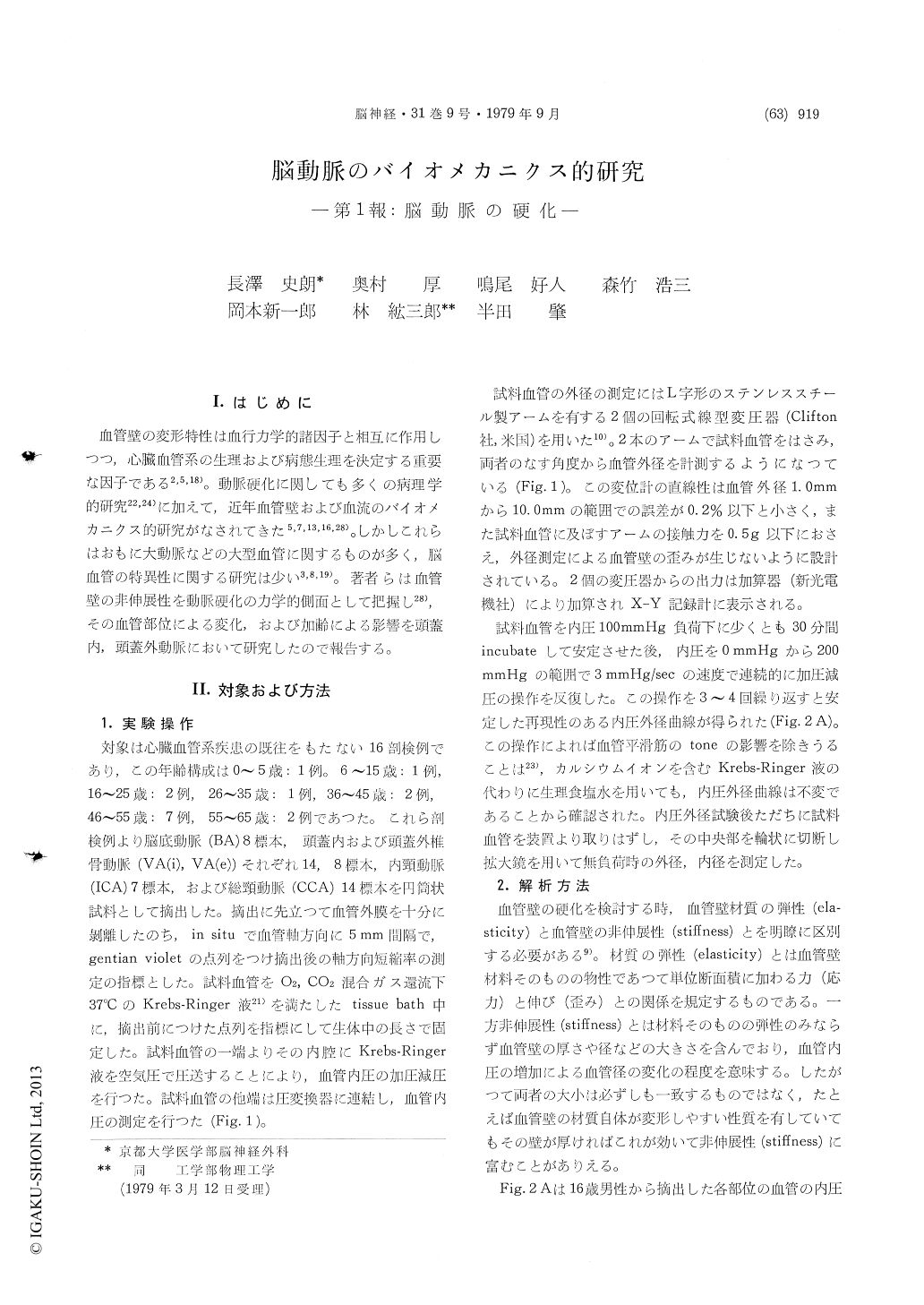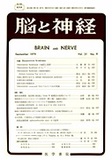Japanese
English
- 有料閲覧
- Abstract 文献概要
- 1ページ目 Look Inside
I.はじめに
血管壁の変形特性は血行力学的諸因子と相互に作用しつつ,心臓血管系の生理および病態生理を決定する重要な因子である2,5,18)。動脈硬化に関しても多くの病理学的研究22,24)に加えて,近年血管壁および血流のバイオメカニクス的研究がなされてきた5,7,13,16,28)。しかしこれらはおもに大動脈などの大型血管に関するものが多く,脳血管の特異性に関する研究は少い3,8,19)。著者らは血管壁の非伸展性を動脈硬化の力学的側面として把握し28),その血管部位による変化,および加齢による影響を頭蓋内,頭蓋外動脈において研究したので報告する。
Human intracranial (vertebral and basilar) and extracranial (internal and common carotid, and vertebral) arteries were studied to evaluate the development of arteriosclerosis from the bio-mechanical point of views. Parameters such as stiffness parameter (β), incremental elastic modulus (Einc), wall thickness ratio (T/Ri), and tangential wall stress (σ) were used in this study. Stiffness parameter (β) was calculated from their intraluminal pressure (Pi) and external radius (R0) relations by the following equation: In (Pi/Ps)=β(R0/Rs-1). Incremental elastic modulus (Einc), proposed by Bergel, represents the elastic properties inherent to the material of vascular wall, whereas the stiffness parameter (β) expresses the indistensibility of a tubular segment against the intraluminal pressure comprehensively, including both wall dimensions such as wall radius and thickness (T), and the elastic modulus like Einc, which is under-stood from the following equation: β=(R0-Ri,) Einc/ (0.75PiRi), where Ri is the internal radius. As one of wall dimensions, the ratio of wall thickness (T) to internal radius (Ri), named wall thickness ratio (T/Ri), was used. Tangential wall stress (σ) was also calculated by the following equation: σ=RiPi/T.
The value of stiffness parameter (β) increases with age, which is well known as "sclerosis". However, there exists a considerable difference between the intracranial and extracranial arteries in the change of wall stiffness with age. The extracranial arteries are relatively distensible (low β-value) with little change in the wall stiffness under 40 years of age. On the contrary, the intra-cranial arteries are already stiff at birth and increase their wall stiffness gradually after birth, which results in a large difference of wall stiffness be-tween the intracranial and extracranial arteries of the middle age. From the biomechanical point of views, these specific features found in the intra-cranial arteries correspond well with the commonoccurrence of cerebral arterial aneurysms not only in the elderly but also in the middle aged persons.
Wall thickness ratio (T/Ri) of the intracranial arteries is significantly low under 45 years of age and increases markedly thereafter. The extra-cranial arteries have high wall thickness ratio under 45 years of age and increase the ratio gradually with age.
The intracranial arteries under 45 years of age have significantly high tangential wall stress (σ), two to three times higher than the extracranial ones. The stresses of both intracranial and extra-cranial arteries over 45 years converge to almost the same range of value. There might be some stress-sensitive mechanism in vascular walls which changes their wall thickness so as to sustain a similar low value of wall stress.
The intracranial arteries under 45 years of age have tremendously higher value of incremental elastic modulus (Einc) than the extracranial arteries of the same age, and decrease the value largely with age. The extracranial arteries show almost no change of their moduli throughout all ages. Therefore, the development of arteriosclerosis in the intracranial arteries attributes not to their increase of elastic modulus but to the marked thickening of the wall with age. In fact, the elastic modulus of the intracranial arteries de-creases with age, which is compensated by the marked thickening of the wall.

Copyright © 1979, Igaku-Shoin Ltd. All rights reserved.


